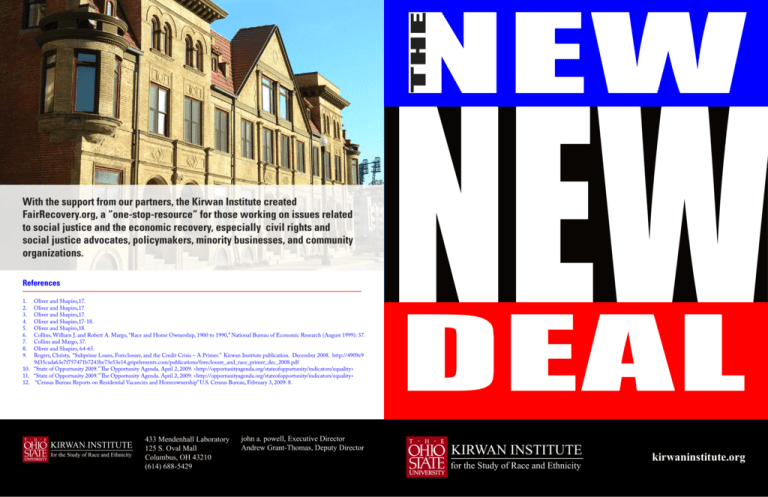The New New Deal - Racial Equity Tools
advertisement

NEW NEW THE With the support from our partners, the Kirwan Institute created FairRecovery.org, a “one-stop-resource” for those working on issues related to social justice and the economic recovery, especially civil rights and social justice advocates, policymakers, minority businesses, and community organizations. References 1. 2. 3. 4. 5. 6. 7. 8. 9. Oliver and Shapiro,17. Oliver and Shapiro,17. Oliver and Shapiro,17. Oliver and Shapiro,17-18. Oliver and Shapiro,18. Collins, William J. and Robert A. Margo, “Race and Home Ownership, 1900 to 1990,” National Bureau of Economic Research (August 1999): 37. Collins and Margo, 37. Oliver and Shapiro, 64-65. Rogers, Christy, “Subprime Loans, Foreclosure, and the Credit Crisis – A Primer.” Kirwan Institute publication. December 2008. http://4909e9 9d35cada63e7f757471b7243be73e53e14.gripelements.com/publications/foreclosure_and_race_primer_dec_2008.pdf 10. “State of Opportunity 2009.” The Opportunity Agenda. April 2, 2009. <http://opportunityagenda.org/stateofopportunity/indicators/equality> 11. “State of Opportunity 2009.” The Opportunity Agenda. April 2, 2009. <http://opportunityagenda.org/stateofopportunity/indicators/equality> 12. “Census Bureau Reports on Residential Vacancies and Homeownership” U.S. Census Bureau, February 3, 2009: 8. 433 Mendenhall Laboratory 125 S. Oval Mall Columbus, OH 43210 (614) 688-5429 john a. powell, Executive Director Andrew Grant-Thomas, Deputy Director DEAL kirwaninstitute.org • • Ten trillion dollars. That’s the amount of government funding in play as the U.S. rolls out its economic stimulus spending program. It’s a staggering and unprecedented dollar amount. But there’s much more at stake than just dollars. Recovery spending will restructure many of our key public institutions in ways that will shape the well-being of generations to come. The very institutional structure of our nation hangs in the balance. So does the financial well-being of our children and theirs. Roosevelt launched the New Deal, and with it new opportunities for owning homes – and accruing wealth – emerged. • With so much at risk, it’s vital to assure that these federal stimulus dollars are spent where they will benefit everyone – particularly those most in need. Too often at critical moments in our history, including postCivil War Reconstruction and the 1960s-era Great Society, we have failed to move as boldly as we might have towards full institutional inclusion for all our people, especially across lines of race and gender. We’re now at another pivotal moment, one that in several ways emerges from institutional changes made under Franklin Delano Roosevelt’s New Deal. Then, as now, crisis led to government measures which restructured our economy and our society. The New Deal By the time of the Great Depression in 1929, home loans required large down payments of around 40 percent, and repayment in three to six years – with high monthly payments few families could afford. In response to the Great Depression, President Franklin • The New Deal made home mortgages more affordable with small down payments, reasonable interest rates and 30-year loans which could be paid off over a working lifetime. Home ownership became more available to middle-class Americans, and in many cases homeownership was actually more affordable than renting.1 The Home Owners Loan Corporation (HOLC) refinanced tens of thousands of mortgages in danger of default or foreclosure.2 However these opportunities were not equally accessible to everyone and the policies put in place created white flight to the suburbs and further disadvantaged black Americans: • “Redlining” meant black communities and individuals could not get loans. Standardized home appraisals, created by the HOLC and used by the Federal Housing Authority (FHA), were color coded based on the ethnic makeup of neighborhoods. New, all-white neighborhoods, designated green, were the most desirable areas for originating new mortgages. In contrast, racially mixed or all-black, old, and undesirable areas were coded red; and areas within the “redline” were extremely unlikely to get loans.3 FHA policies favored movement to the suburbs. FHA loans favored new purchases over repair of existing homes. There was also a bias toward single-family homes, which required the use of open space outside the crowded city. Coupled with redlining, these FHA policies meant the only loans being given were for properties away from the inner-city concentration of African Americans.4 FHA encouraged racially restrictive covenants until 1949. The official Underwriting Manual of the FHA stated “if a neighborhood is to retain stability, it is necessary that properties shall continue to be occupied by the same social and racial classes.” To further this goal, the FHA recommended inserting into each deed an agreement that the new owner would not sell to African American families. This practice continued until such agreements were ruled unenforceable by the U.S. Supreme Court in Shelley v. Kraemer (1948).5 While homeownership for whites and African Americans had remained fairly steady until 1920, by 1940, in the wake of the Great Depression, both rates had plunged by as much as 5%, and in the aftermath of the New Deal, a great divide had developed along racial lines. In 1940 white homeownership was approximately 42%, and African American ownership was only 20%.6 Later, even as both rates increased dramatically in the post-World War II housing boom, this gap in opportunity persisted. White and black home ownership rates maintained over a 25% spread. In 1960 African American home ownership had risen to 40%, but white ownership was at approximately 67%.7 Over the next few decades housing values rose dramatically and the wealth and homeownership gap persisted. Other policies exacerbated these inequities. For instance, the working class was exempted from the financial benefits of Social Security coverage and post-New Deal federal highway polices effectively destroyed many black urban communities. Today’s Wealth Gap Flash forward to the 21st century, and white Americans have built home equity, with many paying off their homes, which had also greatly appreciated in value. Housing equity makes up the largest part of wealth held by the middle class. Now in addition to cultural capital (upbringing, education and contacts), middle class children of baby boomers are beginning to receive inheritances based on the wealth amassed between the late 1940’s and late 1960’s when saving rates were higher and housing costs were much lower.8 But most African Americans have been excluded from that picture of financial growth. Most never qualified for low-cost home loans and were excluded from home ownership, while those who did qualify for home loans often received only the less-desirable high-interest adjustable-rate subprime loans. • People of color are more than three times as likely as whites to have subprime mortgages. • They are also more than 30 percent more likely to have a higher-rate loan than whites, even when demographics are comparable.9 In essence, post-war African Americans were excluded from society’s best source of accrued wealth; and those gaps are apparent today. • In 2004, median household wealth (household assets minus debt) for whites was $118,300, and for blacks it was only $11,800.10 • In 2007, the median income of white families was $69,937. For black families it was $40,143 and for Latino families it was $40,566.11 • In 2008, the homeownership rate for whites was 74.8%. For blacks it was 46.8% and for Latinos it was 48.6%.12 LESSONS LEARNED President Franklin Roosevelt’s extensive package of New Deal economic programs did a great deal to buoy a nation badly buffeted by the winds of the Great Depression. Unfortunately, New Deal Policies largely left African Americans, already the most vulnerable of Americans, far behind. If we can avoid similar inequities in today’s recovery spending, we can stop history from repeating itself and avoid creating another round of historic inequities. Today, the “universal” approach to spending may put already-disadvantaged Americans at an even deeper disadvantage. That is a real risk, unless their needs are kept prominently in mind as we develop a recovery spending plan with an unprecedented price tag.







